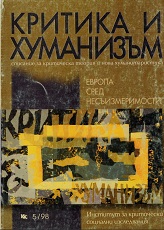Всекидневие и криза (феноменология и критическа теория)
Everyday Life and Crisis (Phenomenology and Critical Theory), part II
Author(s): Andrey RaychevSubject(s): Social Sciences
Published by: Фондация за хуманитарни и социални изследвания - София
Summary/Abstract: The article starts by a thought experiment; an elementary example is taken of an artificially isolated simple human activity (taetigkeit) ('A man is drinking coffee') and the steps are considered in which a possible elementary crisis would deploy in this activity. 'Coffee' turns into 'poured coffee', into 'ground coffee' and finally into 'coffee bought in the shop' A further deployment of this crisis is impossible (because the condition will not be fulfilled for the activity to be isolated). On the basis of this thought experiment (and a few others), an attempt is made to produce a theoretical description of the elementary social crisis. The deployment of the crisis consists, strictly speaking, into the turning of the object from an immediate into a mediated one. More freely speaking, the object in crisis comes out to be an object with a history, or: the object of my activity now comes out to be the former object of other activities (mine and not mine). Thus the crisis unveils the mediating nature of objects: the quiet 'ordinary objects' come out to be mediators. In general, every mediator has a crisis in its origin and every crisis is resolved by the appearance of a new mediator or mediator structure. In its origin, the social mediator is a crisis overcome such is its factual content, irrespective of how social agents might view it. (Of course, the mediatory object can outlive by long the crisis that has generated it; it also can disappear unexpectedly for observers, due to the disappearing of the cyclic crisis that was its condition. A mediator can appear before the crisis, if the crisis has occurred ideally' in the mind of social agents. Especially important is the case when a certain crisis cannot be resolved by a reified mediatory structure and becomes deeper. Analysis shows that if reified structures are not sufficient for the overcoming of a certain crisis, then, in 'mediator things', mediating 'layers' become revealed one after another until a certain social relation becomes 'laid bare' which stands 'in the place of the thing'. I.e. the crisis in the world of things lays bare, in the final account, the fact that all social things are bearers (in a manner that is not overt to the mind) of relations between people. Thus social crisis (in its deep variants) always puts reified structures under 'practical critique' until the revelation of the social relation that is 'hidden' within the thing, therefore, in crises, hidden communicative structures become unveiled. And generally, it can be said that (to follow the terms of the old philosophers), action and communication are opposites and crisis is the mode of their presence together, the way in which human activity regulates human communication and vice versa, without the existence of certain mind 'pre-establishing harmony' between acting and communication.
Journal: Критика и хуманизъм
- Issue Year: 1998
- Issue No: 05
- Page Range: 149-156
- Page Count: 8
- Language: Bulgarian
- Content File-PDF

